Aloe Vera is a famous plant grown indoors and outdoors. If compared only with succulents, Aloe Vera is the fast-grower. But if compared with other plants, Aloe Vera falls in the slow-growing category.
So, in this article, we shall understand how fast an aloe vera plant grows?
The Aloe vera plant grows 1-2 new leaves every month. The plant takes 3 to 4 years to mature and can reach a height of 3 feet with a length of 8-10 inches on matured leaves. To encourage faster growth, provide the plant with appropriate lighting and fertilize it during the growing season.
However, you can boost their growth faster by enhancing their growing conditions and performing certain tricks.
In this article, I will discuss the average growth speed of Aloe Vera plants. I will also share some factors and tricks for the faster growth of Aloe vera plants.
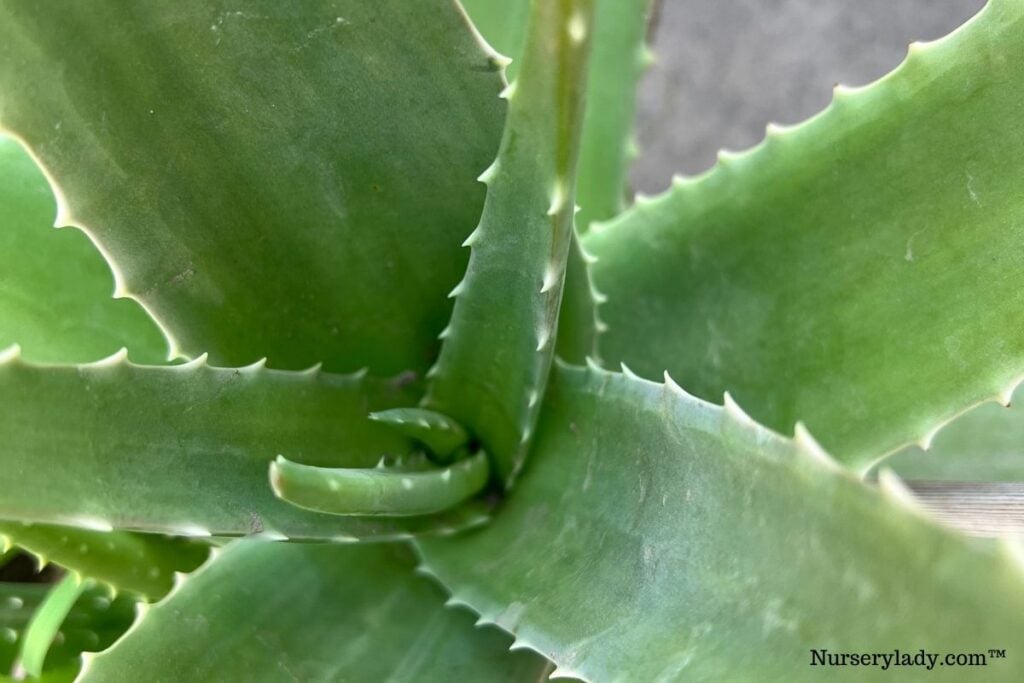
How fast and big does an Aloe Vera plant grow?
Generally, Aloe Vera plants are slow-growing plants.
But among the succulents only, they grow faster than others.
Their growth rate depends on different situations – indoors, outdoors, from seeds, after recent propagation, and after trimming.
Let’s explain them one by one.
Indoors
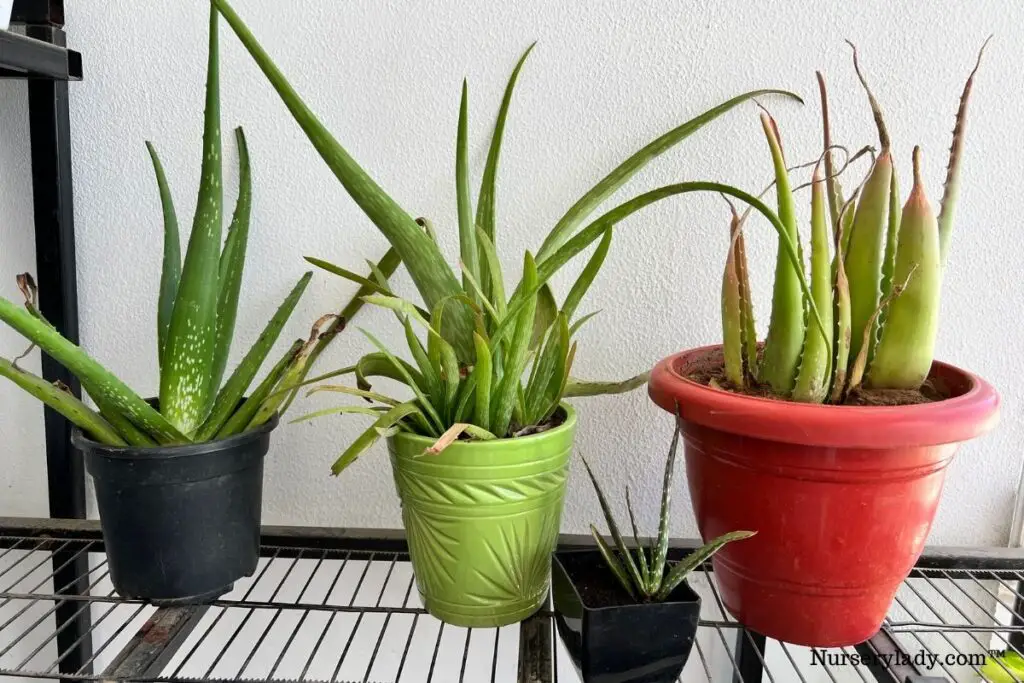
If you are growing Aloe Vera indoors, it will take at least 3 to 4 years to reach maturity.
It is because the light conditions are quite less compared to outdoors.
The more sunlight Aloe Vera receives, the faster it will grow.
Each leaf will take at least one month to sprout out and mature.
Normally, Aloe Vera plants grow around 8 to 10 inches within 3-4 years.
But if they are provided with all their requirements properly, they can reach up to 18 inches.
It will only happen if you take care of the various factors that determine their growth.
Outdoors
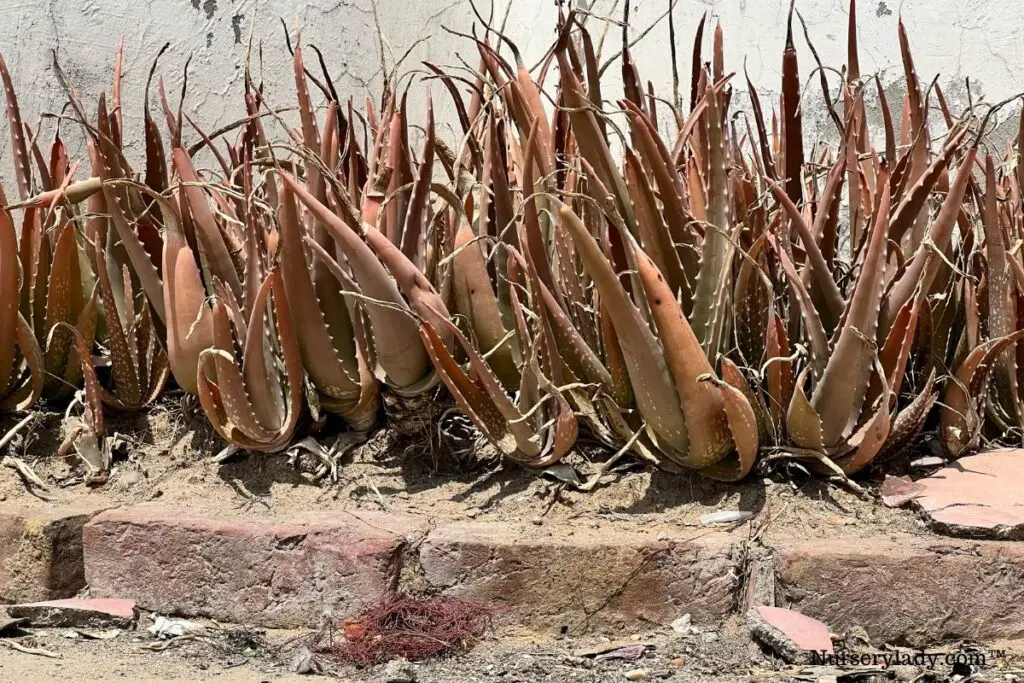
If you grow Aloe Vera plants outdoors, make sure they are under the full sun for at least 5 to 6 hours.
The soil must be well-drained, or it will take a lot of time to dry out.
Aloe Vera will grow faster outdoors in warm weather under the full sun because it is their natural habitat.
The leaves will develop within a month.
The plant size will increase within four months.
From seeds and leaf cuttings
If Aloe Vera gets their ideal growing conditions, including the season and area, it will take 2-4 weeks to grow seedlings.
Seeds sprout more quickly than expected.
But they must meet their suitable growing environment.
It will take 4 to 6 weeks to grow a new Aloe Vera from a leaf.
After trimming
The leaves you choose to trim off must be the old outer leaves.
After cutting, Aloe Vera will take 3 to 5 months to grow and reach its medium size.
However, the timing depends on the plant’s health and size.
Factors determining the growth of Aloe Vera
Many aspects influence the growth rate of an Aloe Vera plant.
The main aspects are the growing conditions: water, light, temperature, soil, and pot.
Looking for gardening supplies? We have tested 100's of products before recommending them to you guys. Check out our best pick below:
| Image | Gardening Supplies | Best Price? |
|---|---|---|
 Top
Top Top
Top | Raised Garden Bed Kit | Check On Amazon |
 | XLUX Soil Moisture Meter, Plant Water Monitor, Soil Hygrometer Sensor for Gardening, Farming, Indoor and Outdoor Plants, No Batteries Required | No Results |
 Top
Top Top
Top | 82 Pcs Garden Tools Set and Extra Succulent Tools Set | Check On Amazon |
 | Joeys Garden Expandable Garden Hose with 8 Function Hose Nozzle, Lightweight Anti-Kink Flexible Garden Hoses, Extra Strength Fabric with Double Latex Core, (50 FT, Black) | No Results |
 Top
Top Top
Top | Dual Chamber Compost Tumbler | Check On Amazon |
 Top
Top Top
Top | Sunnyglade Plant Stakes | Check On Amazon |
 Top
Top Top
Top | Organic Cold Pressed Neem Seed Oil | Check On Amazon |
 Top
Top Top
Top | Mighty Mint Gallon :-Insect and Pest Control Peppermint Oil | Check On Amazon |
 Top
Top Top
Top | Scotts DiseaseEx Lawn Fungicide | Check On Amazon |
 Top
Top Top
Top | Jacks Classic 20-20-20 All Purpose Fertilizer | Check On Amazon |
 Top
Top Top
Top | 30,000 Seeds Pollinator Attracting Wildflower Mixture | Check On Amazon |
 Top
Top Top
Top | Survival Vegetable Seeds Garden Kit-Over 16,000 Seeds | Check On Amazon |
Light
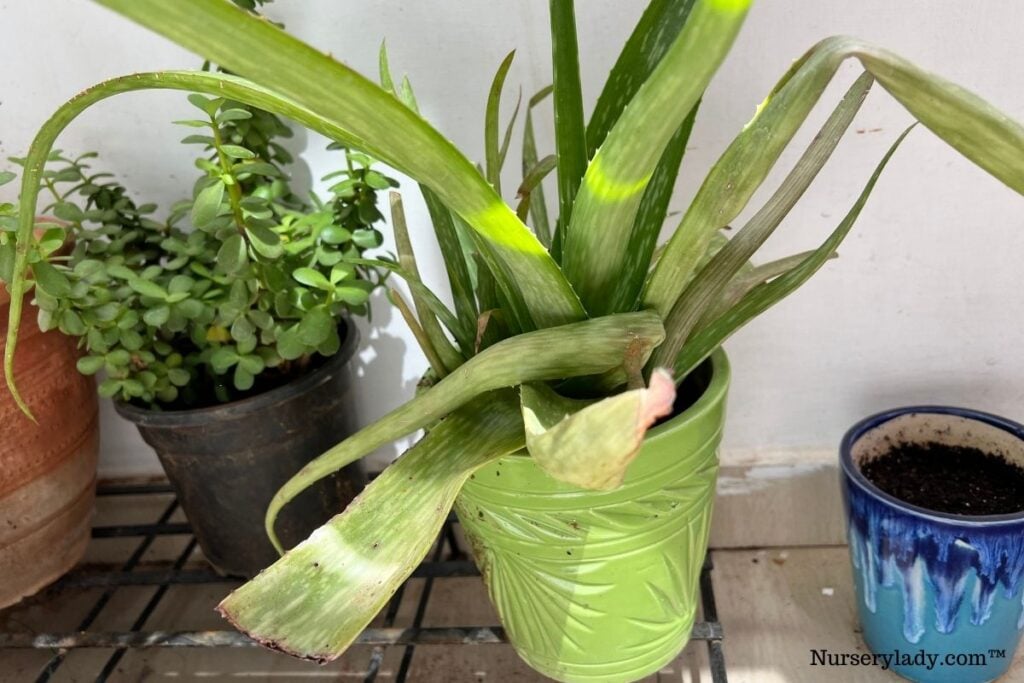
Light plays a vital role in the growth rate of Aloe Vera plants.
Without proper light, they won’t grow properly.
The more sunlight they receive, the faster they will grow.
If Aloe veras don’t receive adequate light, they will struggle to get the nutrients and energy they need for good growth and development.
On the other hand, you must protect them from the scorching sun.
Otherwise, they will get burnt.
This will affect their optimal growth and slow it down.
For encouraging faster growth, you must provide them with 5 to 6 hours of direct sunlight.
Indoor plants rarely get enough sunlight.
So, ensure that they receive at least 3 hours of sun.
Fulfill the remaining light requirements by using grow lights.
However, if you want to keep your Aloe Vera plants short and small, you can let them have indirect light or low light.
Watering patterns
The right amount and frequency of watering differ from time to time, depending on various aspects.
For optimal growth in Aloe Vera plants, you must provide them with water correctly.
The soil must be allowed to dry out properly before the next watering.
In general, Aloe Vera enjoys dry conditions.
So, you don’t have to water them frequently.
Water them once a few inches from the topsoil has dried up completely.
It will give them their best-growing environment.
One of the most common mistakes committed by gardeners is overwatering, especially beginners.
It is the main reason behind plants not growing at the correct rate and dying.
To perform the best watering, you must allow the topsoil to dry out completely before watering.
Soil
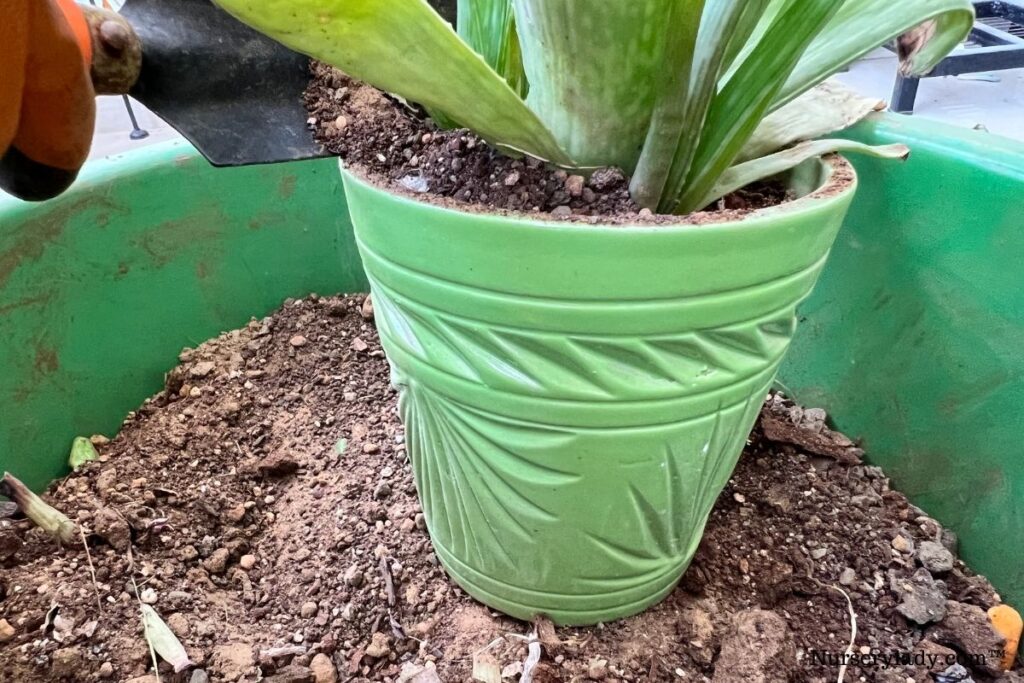
The right amount of soil also determines the watering patterns.
The first and foremost important thing you need to ensure is drainage.
If the soil is not good at drainage, it will suffer overwatering even with a proper watering routine.
Using the correct soil encourages the plant to grow at its usual pace.
On the contrary, the plant will suffer underwatering if the soil doesn’t retain enough water.
Though they enjoy drought conditions, every plant will require water to survive.
The soil must hold the moisture to let the plant absorb it gradually as per its need.
In their natural habitat, they used to grow over deserts where they could naturally fight this dryness.
But, in your garden or house, you must keep them hydrated.
Concentrate more on drainage.
Use gritty materials like sand or gravel more with some garden or potting soil.
The gritty materials will ensure drainage, and the soil will retain moisture for the plant to utilize it gradually as per need.
Pot
The pot for Aloe Vera must be of such a size that the roots can sit well.
Without enough space, the plant cannot grow strong.
In their native land, Aloe Vera plants grow their roots horizontally.
They spread enough to absorb the water from every corner of the soil.
That is why you must choose those planters that are enough wide and not deep.
Another important thing is drainage.
Without drainage holes, the water will not drain, keep the roots damp and result in rotting.
Drainage holes also let some amount of airflow reach the soil so that it can dry faster.
It must be big enough so that the particles in the soil cannot block them, and water flows out with no trouble.
Temperature
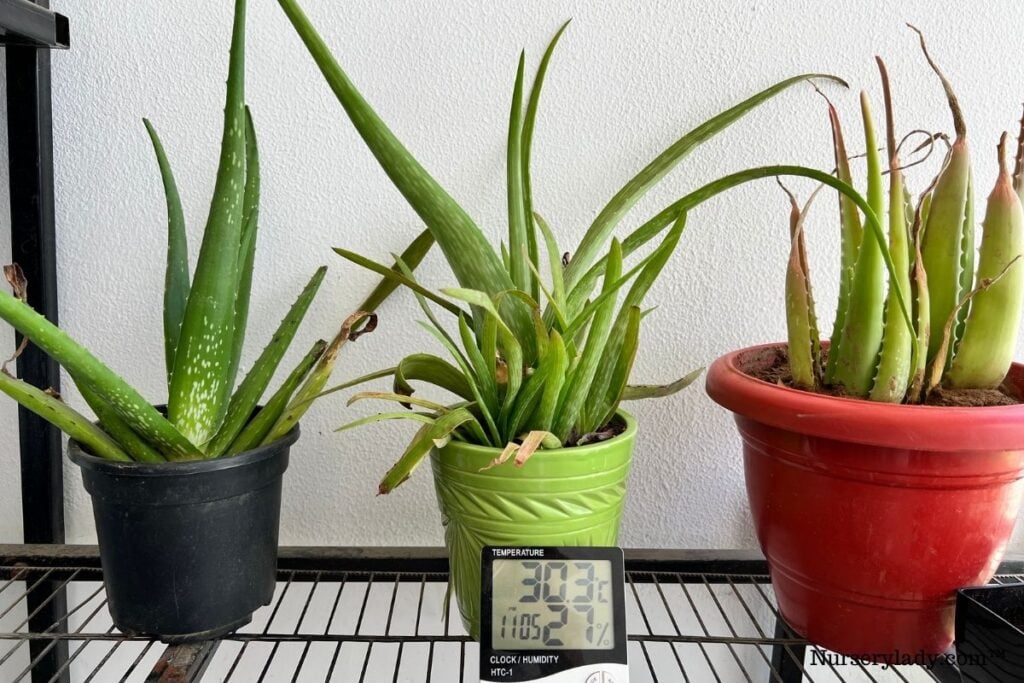
An average temperature ranging between 55-80°F is ideal for Aloe Vera’s health.
If the temperature drops too low or rises too high, the plant will slow down its growth.
Especially during the summers, when the temperature rises above 80-90°F, the plant will grow very slowly and sometimes stop growing.
For optimal growth, ensure that the temperature stays within its ideal range.
Summer dormancy is natural.
But in the winters, you must protect them from the cold and keep them indoors so that they can continue with their normal growth.
How to make Aloe Veras grow faster?
Generally, Aloe Vera is a fast-growing plant among succulents.
But among the other plants, they are considered the slow-growing succulents.
If their growing conditions are maintained properly, they will grow optimally.
But, the plant will not grow at its usual growth if it faces frequent problems.
So, here are also some tips to increase their growth.
Use a pot that is a little bigger than the plant.
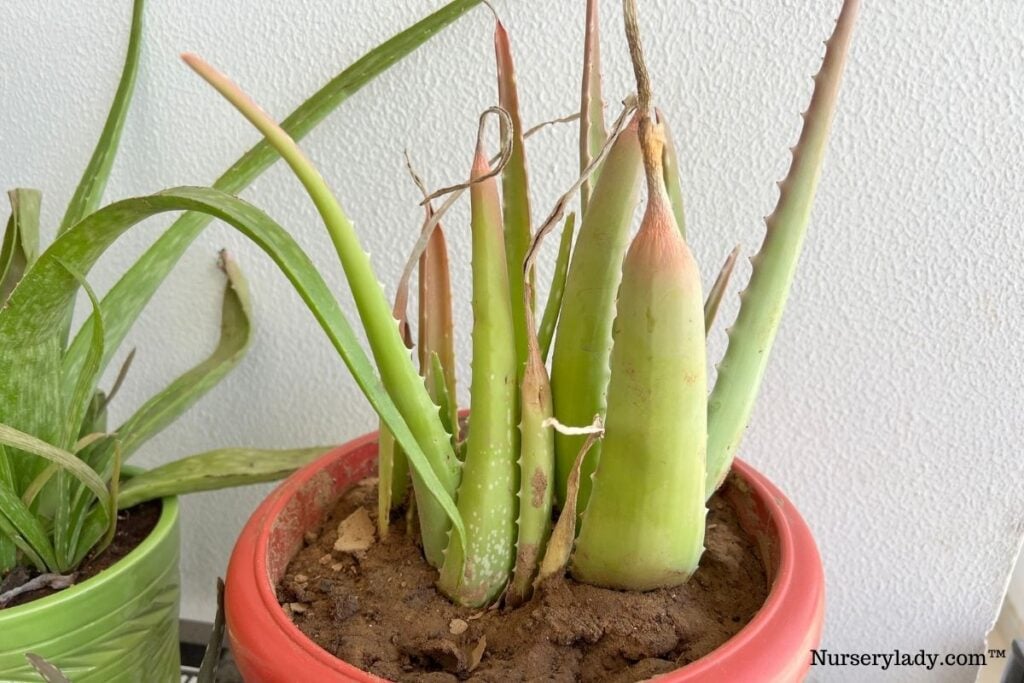
Choose a pot that is 1/3rd bigger than the plant size.
While repotting the Aloe Vera plant, choose a container slightly bigger than the current pot.
It will ensure that the plant’s roots can get enough space to grow and spread.
It will also give the pups enough room to grow and breathe.
With adequate space and oxygen, the plant will grow a little faster than its normal pace.
Even if you forget to repot at the right time, they don’t suffer much as the big pot will still have space.
If the plant doesn’t get enough room to spread its roots and grow pups, they will fight for space and breathe with difficulty, which can further slow down its growth.
So, using a slightly bigger pot can save the plant from this.
Also read: What Pot Is Best For Aloe Vera Plant? (Pot Type, Size & More)
Use the right kind of soil.
The soil you use for Aloe Vera plants must balance drainage and retention, the former being more important.
Aloe Vera plants belong to the desert regions and cannot withstand prolonged dampness.
You should use the right soil if you want your Aloe Vera to maintain its growth pace.
The soil should not hold moisture for a long time and drain gradually.
Use porous ingredients in your Aloe Vera soil mix.
For example, perlite can absorb water in small amounts and drain gradually.
The appropriate type of soil will maintain the optimal growth rate and increase the speed a bit.
A healthy plant without any suffering will grow well.
Some ideal soil mixes are:
Recipe 1
- 50% potting soil
- 50% pumice
This recipe is [erfect for dry regions.
Recipe 2
- 3 parts potting soil
- 2 parts pumice
- 1 part peat
Recipe 3
Equal parts of:
For more soil mix check out: What Type Of Soil For Aloe Vera Plant? (+Ideal Soil Mix)
Watering
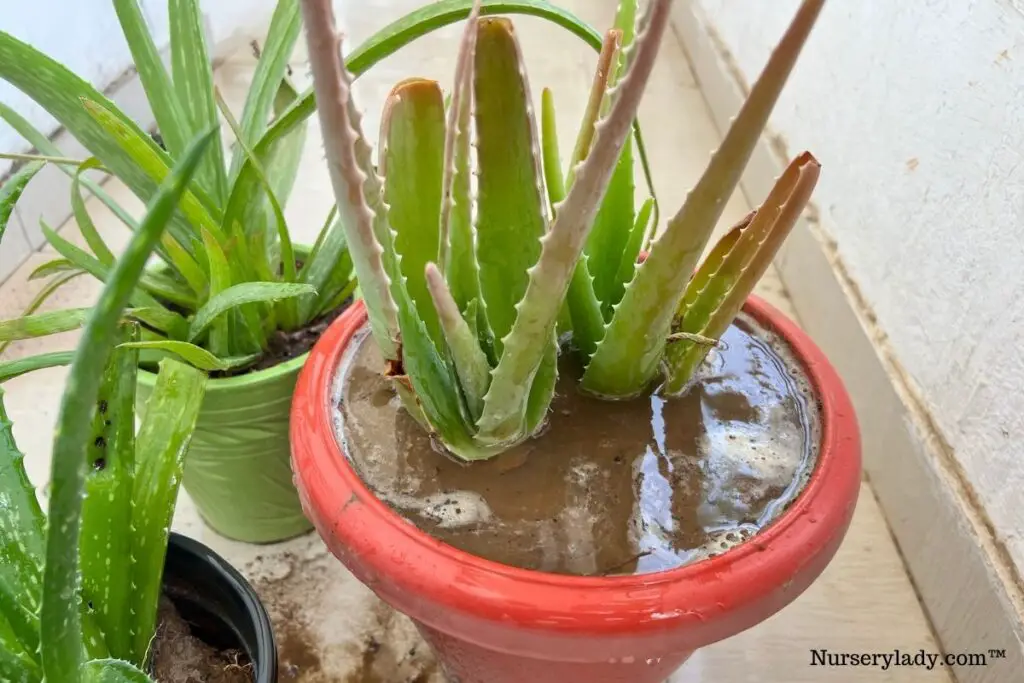
Generally, instead of following any strict routine, water the Aloe Vera plants when the top 2-3 inches of the soil gets dry.
Whenever you water them, water them deeply.
For the next watering, wait until some inches of the topsoil is fully dry.
This will prevent your plant from suffering overwatering and underwatering and keep them healthy in the long run.
After recent planting or repotting, wait for at least 2 weeks to water the Aloe Vera plant.
It helps the roots grow faster and wider in the search for water.
When you water them after two weeks, the plant will get the water they were longing for these two weeks and start to grow busily.
Also read: How To Water Aloe Vera Plant? (How often, Summer, Winter)
Don’t forget to remove the pups.
When the Aloe Veras are mature, they will produce offsets.
Too many pups can cause overcrowding and slow down their growth.
Removing the babies from time to time avoids overcrowding, gives more space to grow and allows the plant to breathe.
The more space the plant will get, they will get to breathe and grow faster.
So, if you want your plant to grow faster, avoid overcrowding by removing the offsets.
Light plays an important role in increasing their growth.
Aloe Veras are sun-loving plants.
If you want your Aloe Veras to grow faster, give them an adequate amount of light.
The more light they get, the faster and larger they will grow.
But, make sure not to burn the plant by exposing them to the harsh sunlight.
For protection, put on transparent shading nets in the planting site.
Indoors, keep them 3 feet back from the south or west-facing window.
It will give them enough light and also help them grow faster.
If you don’t want them to grow bigger, you can give them indirect light.
Also read: What Kind Of Light For Aloe Vera Plants? (Full sun, Shade, Or Partial Light?)
Fertilize them to increase their growth
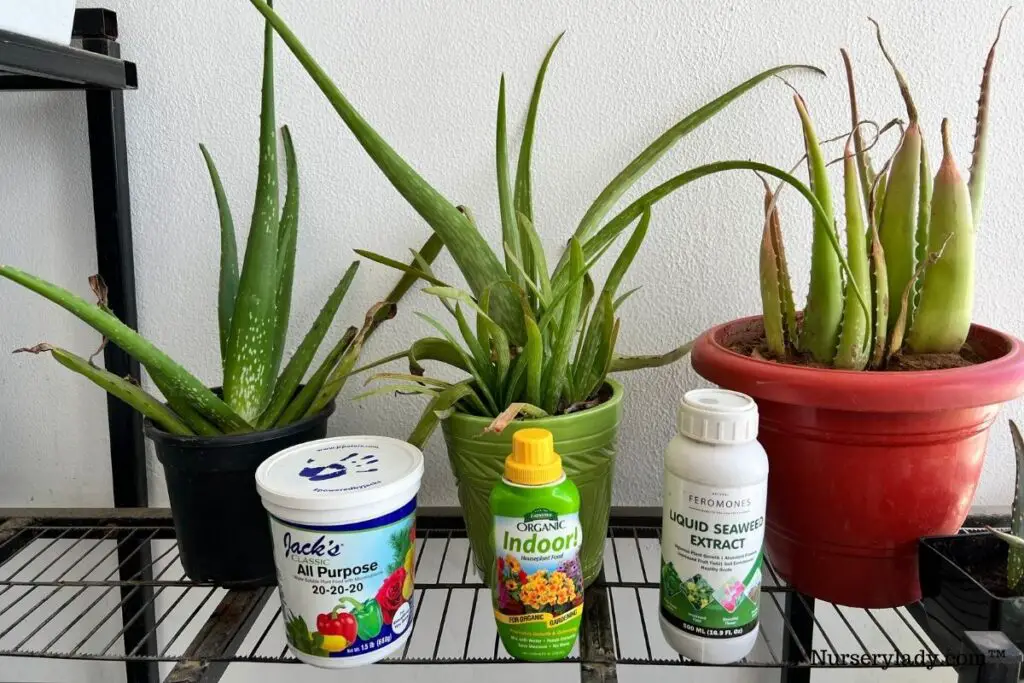
Generally, Aloe Vera plants are not a feeder.
The soil they are standing in is enough to maintain their optimal growth.
Some soil mixes contain ingredients like compost which helps the plant maintain its usual growth.
But, light feeding can boost their growth.
The nutrients you provide them through fertilization will encourage them to grow faster.
Use low-nitrogen fertilizer
Fertilize them during their growing months once after every 6 to 8 weeks.
Always dilute the fertilizer with water and make the strength to half.
It will prevent the plant from suffering chemical burns.
However, if the plant is doing fine without any fertilizers, you can avoid it.
Only use it when you feel like the plant is not growing at its normal speed and they need it.
Do not fertilize them at any offseason, and don’t increase the frequency.
That might lead to over-feeding, which can further give rise to other issues.
Also read: Does Aloe Vera Need Fertilizer? (How Much, How Often+Best Pick)
Provide the ideal temperatures.
As I discussed previously, a temperature range between 55-80°F is suitable for their growth.
Aloe Veras will maintain the ideal growth rate if the temperature stays within this range.
In the summers, Aloe Veras will stop growing due to dormancy.
It is their natural feature.
But, in the winters, you can help them maintain their actual growth rate by bringing them indoors and keeping them in a warm area.
A warm temperature won’t let the Aloe Veras slow down their growth.
In the cold climate, heat mats for plants can warm up the plant and prevent stunted growth and root shock due to cold.
Also read: Aloe Vera Temperature Tolerance: Ideal Temperature+Keeping Them Safe
Shift indoor plants outdoors sometimes.
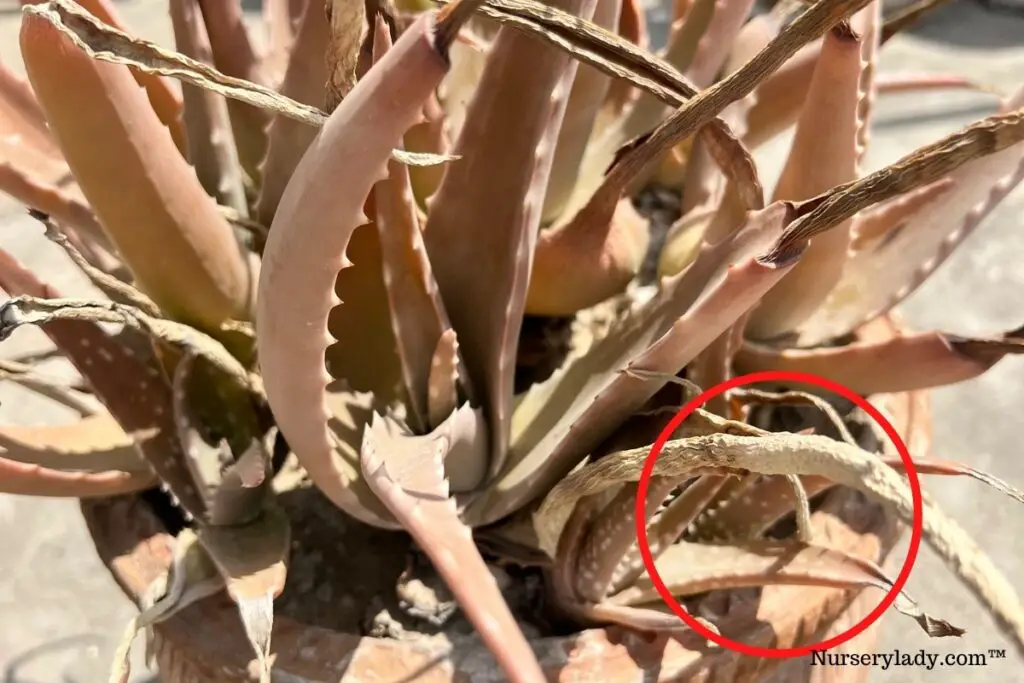
If the climate outside is warm and there is no harsh sunlight, you can keep the plant outdoors for some time.
Getting enough light outdoors will help the plant to increase its growth slightly.
Sometimes, these succulents don’t get as much light as they need for faster and bigger growth indoors.
This tip can make the Aloe Veras grow quickly. Remember not to place under harsh and blasted sunlight.
Bring them indoors when the climate gets cold.
Also read: Is Aloe Vera Indoor Or Outdoor Plant? (+Care Difference)
Try some banana peels.
If you are unsure about fertilizing with chemical fertilizers, you can try banana peels.
Add some chopped banana peels to the growing medium.
Do this at the time of repotting or at the time of planting.
Banana peels contain potassium and slowly release this nutrient.
The plant will absorb them gradually, get boosted, and grow faster.
Use some rooting hormone.
While transplanting pups or propagating by cuttings, you can add some rooting hormones to the wounded portion.
It will help them to grow roots faster than their usual rate.
Wait for some days to water these propagated plants.
Moist the soil slightly by misting.
Once they get established, water them normally.
Allow the soil to dry before watering.
It will save the roots from suffering due to excess moisture.
Also read: Do Aloe Vera Like Humidity? (Ideal Humidity+How To Maintain)
Final words
Some of the tricks to boost Aloe Vera’s growth are already known to you, and some are new.
Try every possible thing to know which one works better for your plant. Trying them helps you to understand the plant’s requirements the best.
Try not to stress the plant by disturbing its growing conditions. If they face any problem, solve it immediately.
Also, don’t stress the plant by doing something extra while following the tricks. Do as suggested. Don’t push your plant too much for faster growth if it is doing fine in its present condition.
Reference: NCBI, New York Botanical Garden, University of New Hampshire, University of Florida, Wikipedia.
